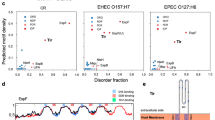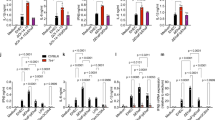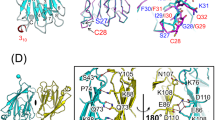Abstract
The protein Tir (translocated intimin receptor) in enteric bacteria shares sequence similarity with the host cellular immunoreceptor tyrosine-based inhibition motifs (ITIMs). Despite the importance of Tir in pedestal formation, relatively little is known about the role of Tir and its ITIMs in the regulation of the host immune response. Here we demonstrate that Tir from enteropathogenic Escherichia coli (EPEC) interacted with the host cellular tyrosine phosphatase SHP-1 in an ITIM phosphorylation–dependent manner. The association of Tir with SHP-1 facilitated the recruitment of SHP-1 to the adaptor TRAF6 and inhibited the ubiquitination of TRAF6. Moreover, the ITIMs of Tir suppressed EPEC-stimulated expression of proinflammatory cytokines and inhibited intestinal immunity to infection with Citrobacter rodentium. Our findings identify a previously unknown mechanism by which bacterial ITIM-containing proteins can inhibit innate immune responses.
This is a preview of subscription content, access via your institution
Access options
Subscribe to this journal
Receive 12 print issues and online access
$209.00 per year
only $17.42 per issue
Buy this article
- Purchase on Springer Link
- Instant access to full article PDF
Prices may be subject to local taxes which are calculated during checkout








Similar content being viewed by others
References
Nataro, J.P. & Kaper, J.B. Diarrheagenic Escherichia coli. Clin. Microbiol. Rev. 11, 142–201 (1998).
Chen, H.D. & Frankel, G. Enteropathogenic Escherichia coli: unravelling pathogenesis. FEMS Microbiol. Rev. 29, 83–98 (2005).
Vallance, B.A. & Finlay, B.B. Exploitation of host cells by enteropathogenic Escherichia coli. Proc. Natl. Acad. Sci. USA 97, 8799–8806 (2000).
Eckmann, L. Animal models of inflammatory bowel disease: lessons from enteric infections. Ann. NY Acad. Sci. 1072, 28–38 (2006).
Kenny, B. et al. Enteropathogenic E. coli (EPEC) transfers its receptor for intimate adherence into mammalian cells. Cell 91, 511–520 (1997).
de Grado, M. et al. Identification of the intimin-binding domain of Tir of enteropathogenic Escherichia coli. Cell. Microbiol. 1, 7–17 (1999).
Luo, Y. et al. Crystal structure of enteropathogenic Escherichia coli intimin-receptor complex. Nature 405, 1073–1077 (2000).
Hayward, R.D., Leong, J.M., Koronakis, V. & Campellone, K.G. Exploiting pathogenic Escherichia coli to model transmembrane receptor signaling. Nat. Rev. Microbiol. 4, 358–370 (2006).
Campellone, K.G. Cytoskeleton-modulating effectors of enteropathogenic and enterohaemorrhagic Escherichia coli: Tir, EspFU and actin pedestal assembly. FEBS J. 277, 2390–2402 (2010).
Beutler, B.A. TLRs and innate immunity. Blood 113, 1399–1407 (2009).
Takeuchi, O. & Akira, S. Pattern recognition receptors and inflammation. Cell 140, 805–820 (2010).
Palm, N.W. & Medzhitov, R. Pattern recognition receptors and control of adaptive immunity. Immunol. Rev. 227, 221–233 (2009).
Salazar-Gonzalez, H. & Navarro-Garcia, F. Intimate adherence by enteropathogenic Escherichia coli modulates TLR5 localization and proinflammatory host response in intestinal epithelial cells. Scand. J. Immunol. 73, 268–283 (2011).
Khan, M.A. et al. Toll-like receptor 4 contributes to colitis development but not to host defense during Citrobacter rodentium infection in mice. Infect. Immun. 74, 2522–2536 (2006).
Lebeis, S.L., Bommarius, B., Parkos, C.A., Sherman, M.A. & Kalman, D. TLR signaling mediated by MyD88 is required for a protective innate immune response by neutrophils to Citrobacter rodentium. J. Immunol. 179, 566–577 (2007).
Gibson, D.L. et al. Toll-like receptor 2 plays a critical role in maintaining mucosal integrity during Citrobacter rodentium-induced colitis. Cell. Microbiol. 10, 388–403 (2008).
Gibson, D.L. et al. MyD88 signaling plays a critical role in host defense by controlling pathogen burden and promoting epithelial cell homeostasis during Citrobacter rodentium-induced colitis. Cell. Microbiol. 10, 618–631 (2008).
Gonçalves, N.S. et al. Critical role for tumor necrosis factor alpha in controlling the number of lumenal pathogenic bacteria and immunopathology in infectious colitis. Infect. Immun. 69, 6651–6659 (2001).
Dann, S.M. et al. IL-6-dependent mucosal protection prevents establishment of a microbial niche for attaching/effacing lesion-forming enteric bacterial pathogens. J. Immunol. 180, 6816–6826 (2008).
Barrow, A.D. & Trowsdale, J. You say ITAM and I say ITIM, let's call the whole thing off: the ambiguity of immunoreceptor signaling. Eur. J. Immunol. 36, 1646–1653 (2006).
Daëron, M., Jaeger, S., Du Pasquier, L. & Vivier, E. Immunoreceptor tyrosine-based inhibition motifs: a quest in the past and future. Immunol. Rev. 224, 11–43 (2008).
Zhang, J., Somani, A.K. & Siminovitch, K.A. Roles of the SHP-1 tyrosine phosphatase in the negative regulation of cell signalling. Semin. Immunol. 12, 361–378 (2000).
Neel, B.G., Gu, H. & Pao, L. The 'Shp'ing news: SH2 domain-containing tyrosine phosphatases in cell signaling. Trends Biochem. Sci. 28, 284–293 (2003).
Higashi, H. et al. SHP-2 tyrosine phosphatase as an intracellular target of Helicobacter pylori CagA. Science 295, 683–686 (2002).
Smith, K., Humphreys, D., Hume, P.J. & Koronakis, V. Enteropathogenic Escherichia coli recruits the cellular inositol phosphatase SHIP2 to regulate actin-pedestal formation. Cell Host Microbe 7, 13–24 (2010).
Inoue, J., Gohda, J. & Akiyama, T. Characteristics and biological functions of TRAF6. Adv. Exp. Med. Biol. 597, 72–79 (2007).
Chen, Z.J. Ubiquitin signalling in the NF-κB pathway. Nat. Cell Biol. 7, 758–765 (2005).
Xia, Z.P. et al. Direct activation of protein kinases by unanchored polyubiquitin chains. Nature 461, 114–119 (2009).
Dean, P. & Kenny, B. The effector repertoire of enteropathogenic E. coli: ganging up on the host cell. Curr. Opin. Microbiol. 12, 101–109 (2009).
Marchés, O. et al. Role of tir and intimin in the virulence of rabbit enteropathogenic Escherichia coli serotype O103:H2. Infect. Immun. 68, 2171–2182 (2000).
Deng, W.Y. et al. Citrobacter rodentium translocated intimin receptor (Tir) is an essential virulence factor needed for actin condensation, intestinal colonization and colonic hyperplasia in mice. Mol. Microbiol. 48, 95–115 (2003).
Nadler, C. et al. The type III secretion effector NleE inhibits NF-κB activation. PLoS Pathog. 6, e1000743 (2010).
Newton, H.J. et al. The type III effectors NleE and NleB from enteropathogenic E. coli and OspZ from Shigella block nuclear translocation of NF-κB p65. PLoS Pathog. 6, e1000898 (2010).
Vossenkämper, A. et al. Inhibition of NF-κB signaling in human dendritic cells by the enteropathogenic Escherichia coli effector protein NleE. J. Immunol. 185, 4118–4127 (2010).
Zhang, L. et al. Cysteine methylation disrupts ubiquitin-chain sensing in NF-κB activation. Nature 481, 204–208 (2011).
Royan, S.V. et al. Enteropathogenic E. coli non-LEE encoded effectors NleH1 and NleH2 attenuate NF-κB activation. Mol. Microbiol. 78, 1232–1245 (2010).
Sham, H.P. et al. Attaching and effacing bacterial effector NleC suppresses epithelial inflammatory responses by inhibiting NF-κB and p38 mitogen-activated protein kinase activation. Infect. Immun. 79, 3552–3562 (2011).
Ruchaud-Sparagano, M.H., Mühlen, S., Dean, P. & Kenny, B. The enteropathogenic E. coli (EPEC) Tir effector inhibits NF-κB activity by targeting TNFα receptor-associated factors. PLoS Pathog. 7, e1002414 (2011).
Campellone, K.G. et al. Clustering of Nck by a 12-residue Tir phosphopeptide is sufficient to trigger localized actin assembly. J. Cell Biol. 164, 407–416 (2004).
Campellone, K.G. & Leong, J.M. Nck-independent actin assembly is mediated by two phosphorylated tyrosines within enteropathogenic Escherichia coli Tir. Mol. Micobiol. 56, 416–432 (2005).
Phillips, N., Hayward, R.D. & Koronakis, V. Phosphorylation of the enteropathogenic E. coli receptor by the Src-family kinase c-Fyn triggers actin pedestal formation. Nat. Cell Biol. 6, 618–625 (2004).
Nandan, D., Lo, R. & Reiner, N.E. Activation of phosphotyrosine phosphatase activity attenuates mitogen-activated protein kinase signaling and inhibits c-FOS and nitric oxide synthase expression in macrophages infected with Leishmania donovani. Infect. Immun. 67, 4055–4063 (1999).
Zhang, Z., Jimi, E. & Bothwell, A.L. Receptor activator of NF-κB ligand stimulates recruitment of SHP-1 to the complex containing TNFR-associated factor 6 that regulates osteoclastogenesis. J. Immunol. 171, 3620–3626 (2003).
An, H. et al. Phosphatase SHP-1 promotes TLR- and RIG-I-activated production of type I interferon by inhibiting the kinase IRAK1. Nat. Immunol. 9, 542–550 (2008).
Gu, H., Griffin, J.D. & Neel, B.G. Characterization of two SHP-2-associated binding proteins and potential substrates in hematopoietic cells. J. Biol. Chem. 272, 16421–16430 (1997).
Campellone, K.G., Giese, N., Tipper, O.J. & Leong,, J.M. A tyrosine-phosphorylated 12-amino-acid sequence of enteropathogenic Escherichia coli Tir binds the host adaptor protein Nck and is required for Nck localization to actin pedestals. Mol. Microbiol. 43, 1227–1241 (2002).
Kong, L. et al. An essential role for RIG-I in toll-like receptor-stimulated phagocytosis. Cell Host Microbe 6, 150–161 (2009).
Kong, X.N. et al. LPS-induced down-regulation of signal regulatory protein α contributes to innate immune activation in macrophages. J. Exp. Med. 204, 2719–2731 (2007).
Yu, M. et al. An essential function for β-arrestin 2 in the inhibitory signaling of natural killer cells. Nat. Immunol. 9, 898–907 (2008).
Song, X.Y. et al. IL-17RE is the functional receptor for IL-17C and mediates mucosal immunity to infection with intestinal pathogens. Nat. Immunol. 12, 1151–1158 (2011).
Acknowledgements
We thank J. Leong (University of Massachusetts Medical School) for cDNA encoding Tir and for JPN15 and JPN15ΔTir; R. Longnecker (Northwestern University) for cDNA encoding LMP2A; H. Gu (University of Colorado Denver) for the SHP-1 construct; B. Finlay and W. Deng (University of British Columbia) for C. rodentium, C. rodentiumΔTir, EPEC strain E2348/69 and ΔescN and technical help; X. Song for help with animal infection; and members of the B. Ge laboratory for discussions and technical assistance. Supported by the National Basic Research Program of China (973 Programs 2012CB578100 and 2011CB505000), the National Natural Science Foundation of China (project 31030028) and the Science and Technology Commission of Shanghai Municipality (Program 10JC1416400).
Author information
Authors and Affiliations
Contributions
D.Y., X.C. and B.G. designed this study; D.Y. did experiments, assisted by X.W. and L.L.; D.Y. and B.G. analyzed the data and wrote the manuscript; and all authors discussed the results and commented on the manuscript.
Corresponding author
Ethics declarations
Competing interests
The authors declare no competing financial interests.
Supplementary information
Supplementary Text and Figures
Supplementary Figures 1–10 (PDF 2427 kb)
Rights and permissions
About this article
Cite this article
Yan, D., Wang, X., Luo, L. et al. Inhibition of TLR signaling by a bacterial protein containing immunoreceptor tyrosine-based inhibitory motifs. Nat Immunol 13, 1063–1071 (2012). https://doi.org/10.1038/ni.2417
Received:
Accepted:
Published:
Issue Date:
DOI: https://doi.org/10.1038/ni.2417
This article is cited by
-
Talaromyces marneffei suppresses macrophage inflammation by regulating host alternative splicing
Communications Biology (2023)
-
Artificial intelligence-rationalized balanced PPARα/γ dual agonism resets dysregulated macrophage processes in inflammatory bowel disease
Communications Biology (2022)
-
Extracellular fibrinogen-binding protein released by intracellular Staphylococcus aureus suppresses host immunity by targeting TRAF3
Nature Communications (2022)
-
Host-mediated ubiquitination of a mycobacterial protein suppresses immunity
Nature (2020)
-
Oxidization of TGFβ-activated kinase by MPT53 is required for immunity to Mycobacterium tuberculosis
Nature Microbiology (2019)



